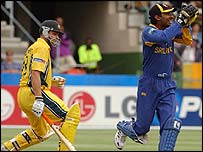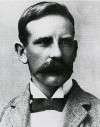A Short History of Walking
David Mutton |
One of the great things about the Ashes is that it brings cricket into the forefront of the English and Australian national consciousnesses. Alas the trade-off of greater interest is a lot of claptrap commentary from people with only a passing interest in the sport.
This was never clearer than when Stuart Broad did not walk after nicking the ball. Richard Dawkins called Broad ‘a revolting cheat’, ‘dishonest and contemptible’, and felt ‘sad cricket’s descended to this.’ The Radio Five Live host Peter Allen said ‘I always thought cricket was something different.’ Sports writers were not immune from the hyperbole, with Oliver Holt comparing Broad to Lance Armstrong and railing against ‘people who have allowed cricket to become snared in a kind of moral nihilism.’ Hell, the crowd at Lords even jeered Jimmy Anderson under the mistaken assumption that he was the villain of the hour, Broad.
I am not qualified to make judgments on the moralism of walking; for that I point you to Samir Chopra and David Coady’s article on the issue. But Dawkins, Allen, and Holt all hark back to an era when walking was the normal behaviour. This was simply not the case for the large majority of cricket’s history.
As Simon Rae demonstrates, in his excellent It’s Not Cricket, walking was only consistently the accepted practice in England from 1945 to around 1970. Lord Harris, who more than anyone created the notion of the spirit of cricket, admitted that he did not walk even when he knew that he was out. In general amateurs, despite supposedly upholding an ethos where winning was less important than style and spirit, happily and knowingly benefited from umpires who knew on which side their bread was buttered.
It was not merely the hypocrisy of amateurs that led to a lack of walking. Professionals also left the decision to the umpire. Jack Hobbs refused to walk for an obvious catch to the wicketkeeper and denied he had touched the ball when accosted by the bowler, Gubby Allen. However when they discussed the incident a few weeks later Hobbs told Allen that he did not want to embarrass the umpire; “it’s unfair on him”, Hobbs said, “and furthermore, if I had [admitted it], he would almost certainly have given me out at the next opportunity?”
One intriguing story from the 1930s suggests that walking was every bit as contentious then as now. In a championship match between Essex and Gloucestershire, Walter Hammond was caught in the covers but refused to walk. The Essex captain, Johnny Douglas, stormed into the Gloucestershire dressing room during tea and said to Hammond “you’ve got a bloody sauce, you know you were out.” The following day Hammond, usually reluctant to bowl at all, demanded the ball and ripped into Douglas, hitting him, knocking his bat out of his hands and eventually bowling him.
Walking only became the standard in England in the post-war years. As early as the first test of the 1946-47 Ashes Walter Hammond was livid with his nemesis Don Bradman when he stayed at the crease after edging a ball low to the slips. “A fine bloody way to start a series” Hammond chuntered. In the southern counties those who refused to walk were considered somewhere between a cad and a cheat, although the dour professionals of Yorkshire and Lancashire consistently frowned on such fripperies.
Double standards were evident even in this supposed halcyon era of walking. Colin Cowdrey, for example, was renowned for walking ‘for obvious decisions, and then not doing so for the less obvious, in the hope that his reputation would fool the umpire.’ Indeed this could be seen as Broad’s real crime as he walked when he edged the ball to Brad Haddin after establishing a lead of nearly 300.
By the 1970s the demands of the professional era and the expansion of the international game flipped the equation once more. The Australians, the logic went, never walked so why should the English put themselves at a disadvantage? In the world of professional cricket the issue is no longer contentious, with at least two generations of former players advocating staying at the crease. It is only those who romantically imagine a glorious golden era where the spirit of the game trumped other concerns who dream other dreams.





Is it true that it was Chris Broad who cleared Barbie when he refused to walk?
Comment by Agent Nationaux | 12:00am BST 30 July 2013
Nice read 🙂
Comment by Agent Nationaux | 12:00am BST 30 July 2013
Cleared him of what, exactly?
As I said at the time, at least Stuart walks once the umpire has given him out, unlike his father on one famous occasion.
Comment by wpdavid | 12:00am BST 31 July 2013
Is David Mutton the chap who writes Silly Mid Off? Nice addition.
Comment by Howe_zat | 12:00am BST 31 July 2013
Interesting article.
In the extensive reading on the history of the game I have done it is interesting that walking, or batsmen not waiting for the umpire to decide on ‘boderline’ catches, is not mentioned in reports, accounts or memoirs before the post WW2 period.
One notable player of the 20s/30s period reckoned that the amateurs never walked and if a paid player did they would certainly face the wrath of their captain and, depending on the importance of the player, might well be dropped for the following game. This was also the case before then.
I suspect that the social and economic pressures post WW2, which eventually meant the Gentleman and Players idea became untenable, caused the idea of ‘walking’ to appear. It gave the ‘gentleman’ a supposed superiority which kept them relevant.
Comment by Biryani Pillow | 12:00am BST 31 July 2013
I walked to a bat pad when I was 18 because I was 95% sure I had hit it. The captain was livid with me and told me he would drop me if I ever walked again precisely because on the spur of the moment you can be influenced by the pressure of the appeal he claimed. 95% sure is not good enough.
Comment by Hurricane | 12:00am BST 31 July 2013